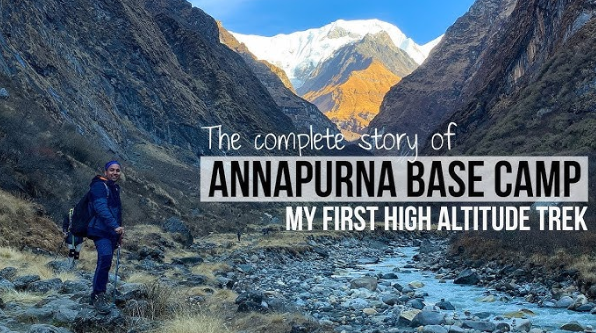The Annapurna Base Camp Trek (ABC Trek) is one of the most iconic and breathtaking trekking experiences in Nepal. Surrounded by the majestic peaks of the Annapurna range, this journey takes adventurers deep into the heart of the Himalayas. The trail blends awe-inspiring mountain views, rich local culture, and diverse landscapes — making it one of the most rewarding treks in the world.
Unlike the more remote Kanchenjunga or Manaslu treks, the ABC route is accessible, well-organized, and suitable for both experienced trekkers and first-timers eager to experience Nepal’s mountain magic.
Overview of the Annapurna Base Camp Trek
Located in the Annapurna Conservation Area, this trek leads to the base of Mount Annapurna I (8,091m) — the world’s 10th-highest mountain. The base camp itself sits at an altitude of 4,130 meters (13,550 ft), surrounded by towering peaks like Machapuchare (Fishtail, 6,993m), Annapurna South (7,219m), and Hiunchuli (6,441m).
The trail begins in the subtropical lowlands near Pokhara, passes through lush forests, terraced fields, and traditional Gurung and Magar villages, and gradually climbs to the alpine landscapes near the base camp. Every step introduces you to new scenery and a deeper sense of tranquility.
Trek Highlights
- Panoramic views of the Annapurna and Dhaulagiri ranges.
- Trek through charming villages like Ghandruk, Chhomrong, and Deurali.
- Relax in natural hot springs at Jhinu Danda after long hiking days.
- Witness breathtaking sunrises from Poon Hill or Machapuchare Base Camp.
- Explore the Annapurna Sanctuary, a natural amphitheater of snow-capped giants.
- Experience warm Gurung hospitality and local culture.
Best Time to Trek
The best time for the Annapurna Base Camp Trek is during spring (March–May) and autumn (September–November).
- Spring: The forests are alive with blooming rhododendrons and clear skies.
- Autumn: Offers the most stable weather, crisp mountain views, and mild temperatures.
Winter (December–February) can be cold, but some trekkers enjoy the quiet trails. The monsoon season (June–August) is not ideal due to heavy rain and slippery paths.
Duration and Route
The trek typically takes 7 to 12 days, depending on the route and pace. Many trekkers start from Nayapul (a short drive from Pokhara) and pass through Ghandruk, Chhomrong, Bamboo, and Deurali before reaching Annapurna Base Camp.
A popular itinerary includes a side trip to Poon Hill (3,210m) — a famous sunrise viewpoint offering panoramic Himalayan vistas.
Sample 10-Day Itinerary
Day 1: Drive from Pokhara to Nayapul and trek to Ghandruk (1,940m).
Day 2: Trek to Chhomrong (2,170m), a beautiful Gurung village.
Day 3: Descend to Bamboo (2,310m) through bamboo and rhododendron forests.
Day 4: Continue to Deurali (3,200m), with stunning mountain views.
Day 5: Trek to Annapurna Base Camp (4,130m) via Machapuchare Base Camp.
Day 6: Enjoy sunrise over Annapurna peaks and descend to Bamboo.
Day 7: Trek to Jhinu Danda (1,780m) and relax in natural hot springs.
Day 8: Return to Nayapul and drive back to Pokhara.
Day 9–10: Optional rest or sightseeing days in Pokhara.
Culture and People
The Annapurna region is rich in cultural diversity. The main ethnic groups — Gurung and Magar — are known for their warmth, hospitality, and strong traditions. Trekkers often stay in local teahouses run by families, offering an authentic glimpse into Himalayan life.
During your stay, you’ll hear stories of Gurkha soldiers, taste traditional dishes like dal bhat (rice and lentils), and experience local customs rooted in Buddhism and Hinduism. Small monasteries, prayer flags, and chortens (stupas) line the trails, reflecting the deep spiritual connection between the people and the mountains.
Trek Difficulty and Fitness Level
The Annapurna Base Camp Trek is classified as moderate, meaning it’s achievable for most trekkers with basic fitness. The daily walking distance ranges from 5–7 hours, with gradual ascents and descents.
While the trek doesn’t require technical climbing, trekkers should be prepared for altitude changes — especially above 3,000 meters. Proper acclimatization, hydration, and pacing are essential to avoid altitude sickness. Training with cardio and leg-strengthening exercises before the trek is highly recommended.
Accommodation and Food
Accommodation along the Annapurna Base Camp route is in teahouses, which are simple but comfortable. Rooms usually include twin beds, blankets, and shared bathrooms.
Meals are hearty and nourishing, with options like dal bhat, noodles, soups, pasta, and pancakes. Most teahouses also serve hot drinks like ginger tea and coffee, helping trekkers warm up after cold hiking days.
Permits and Entry Requirements
To trek in the Annapurna region, you’ll need two permits:
- Annapurna Conservation Area Permit (ACAP) – Protects local biodiversity.
- Trekkers’ Information Management System (TIMS) Card – Records trekking details for safety.
Both permits can be obtained in Kathmandu or Pokhara before your trek.
Trekking Costs
The Annapurna Base Camp Trek is relatively affordable compared to other Himalayan routes. The average cost ranges from USD 700–1,200 per person, depending on the duration, group size, and services.
This typically includes:
- Trekking permits
- Accommodation and meals
- Guide and porter fees
- Transportation to and from Pokhara
- Basic first aid and safety equipment
Optional costs include tips, snacks, Wi-Fi, and hot showers.
Wildlife and Scenery
As you ascend, the scenery transforms dramatically — from rice terraces and rhododendron forests to alpine meadows and glacial moraines. The Annapurna Conservation Area is home to over 1,200 plant species and 100+ mammals, including Himalayan tahr, langurs, and snow leopards.
Spring is especially beautiful, with colorful rhododendrons and crystal-clear skies framing the snow-covered peaks.
Why Choose the Annapurna Base Camp Trek?
- Accessibility: Easier logistics compared to remote treks like Kanchenjunga or Dolpo.
- Moderate challenge: Suitable for beginners with moderate fitness.
- Cultural richness: Blend of Gurung, Magar, and Thakali traditions.
- Diverse scenery: From lush valleys to the icy Annapurna Sanctuary.
- Year-round appeal: Safe and enjoyable for most of the year.
The ABC trek offers the perfect balance of adventure, culture, and comfort — making it one of the best introductions to Himalayan trekking.
Tips for a Successful Trek
- Train before you go: Build stamina with hiking and cardio exercises.
- Pack light but smart: Bring layers, waterproof gear, and a sleeping bag.
- Stay hydrated: Drink plenty of water to adapt to altitude.
- Acclimatize properly: Don’t rush the ascent — take rest days if needed.
- Hire local guides and porters: They enhance safety and support local livelihoods.
Conclusion
The Annapurna Base Camp Trek is more than just a hiking journey — it’s a soulful experience that connects you with nature, culture, and the breathtaking grandeur of the Himalayas. Standing at the base of Annapurna, surrounded by towering peaks that glow under the sunrise, you’ll feel a deep sense of peace and accomplishment.
This trek combines the best of Nepal — natural beauty, cultural warmth, and adventure — making it an unforgettable experience for trekkers from around the world. Whether it’s your first trek or your next big challenge, the Annapurna Base Camp promises memories that will last a lifetime.




